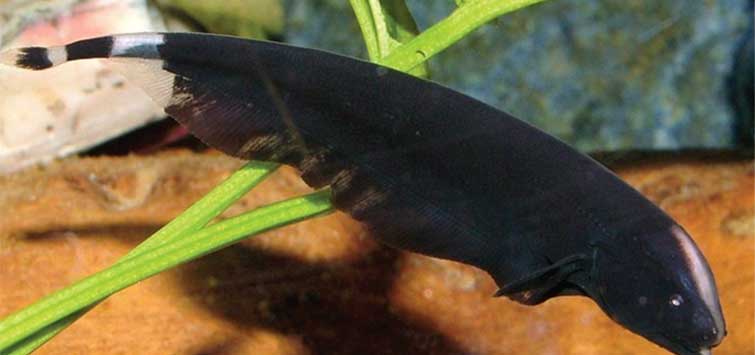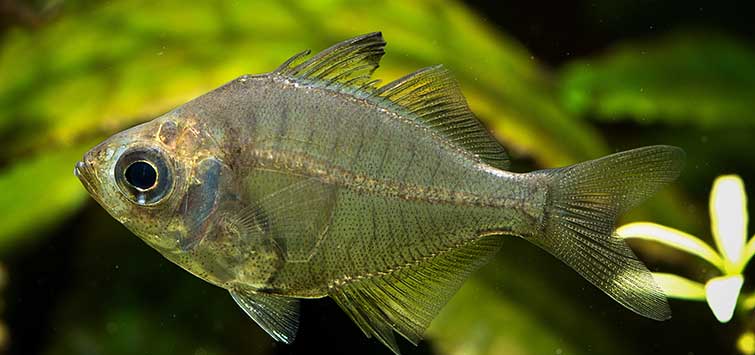Apteronotus albifrons
Common Names: Apteronotid eel, black ghost, black ghost knifefish, black knife
Type Locality: Suriname
Range: South America: Venezuela to Paraguay and ParanÁ Rivers, also the Amazon Basin of Peru
Taxonomic Troubles: Originally described as Gymnotus albifrons; you may see it called Apteronotus passan, Sternarchus albifrons, S. lacepedii, and S. maximilliani.
Size: 50 cm (20 inches).
Preferred Water Chemistry: Tropical freshwater. Like most fishes with a broad distribution, it is quite tolerant of various water chemistries.
Difficulty: Hardy. Wild-caught specimens may need to be trained to take nonliving foods, though this isn’t usually difficult.
Tank Setup: The tank must take into account three needs: 1) room—at an adult size of almost 2 feet, this stiff-bodied fish cannot bend and needs a wide tank front to back so it can turn around; 2) shelter—this nocturnal fish needs a safe place as a daytime home; 3) t
Feeding: A micropredator. Much of its natural diet is insect larvae. Besides live foods, you should offer various frozen, freeze-dried, and pellet foods. The fish has a relatively small mouth for such a large fish, but it is still substantial, and the fish will ea
Breeding: Not commonly bred by hobbyists, though it is reported to be fairly easily spawned. Two obstacles are that the fish must be about half grown before they are sexually mature, and it is difficult to keep two specimens in the same aquarium.
Fish Description
Has the typical culteriform (knife-like) shape of knifefishes. This species has no caudal or dorsal fin. It swims gracefully using the anal fin, which stretches along the belly to the tail, undulating it to move equally easily forward or backward. The fish is allover black, with a white dorsal stripe and two white bands around the tail.
Notes
The black ghost knife has been steadily popular for many decades. Its strange appearance, unusual behavior, and hovering swimming style appeal to many aquarists. Unfortunately, this fish is usually sold as a baby, and many people buy one without having a tank large enough for the adult. Although this is a relative of the extremely dangerous electric eel Electrophorus electricus, the black ghost poses no electrical danger to you or to its tankmates. You would need a very sensitive meter to detect the weak field the fish generates. It uses the field to navigate through dark, murky habitats, to locate prey, and to communicate with others of its species (e.g., to challenge interlopers or find a mate). In the confines of a tank, electrogenic fish can be stressed by the presence of other such fish because their fields overlap continuously. This is a fascinating fish for the larger aquarium.

.png?h=595&iar=0&w=2781&hash=5FD5E69473BCC22199FBFA2FB71B6033)



